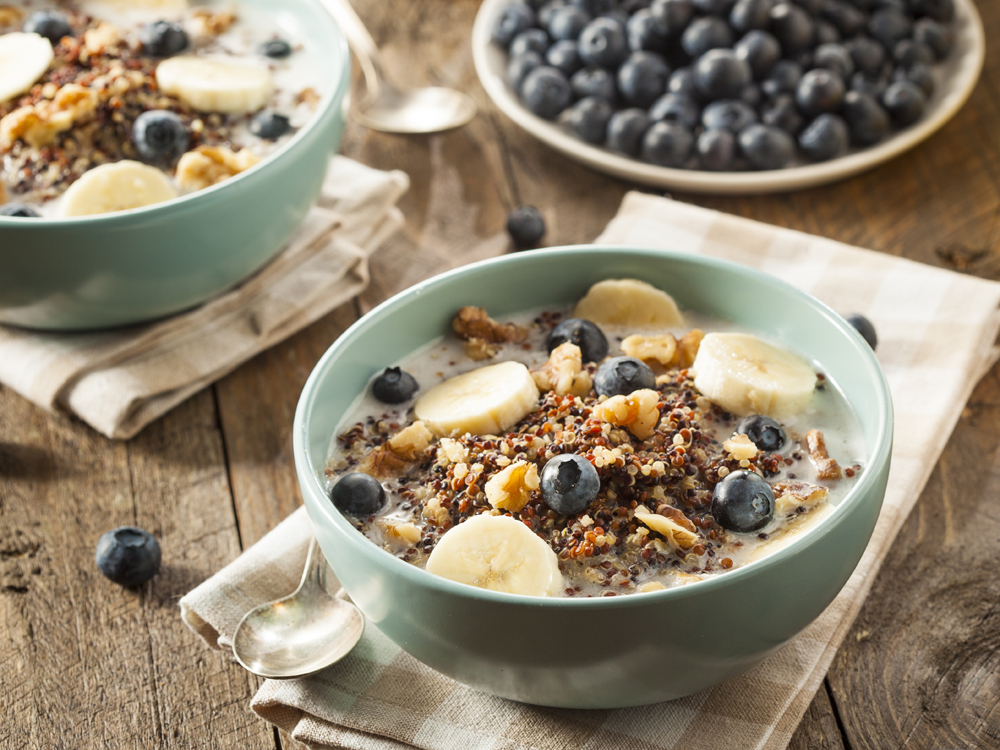
By Vanessa Hrvatin
Fibre is known to be an important part of a nutritious diet, yet most of us are notoriously bad at getting enough of it. It’s estimated that most Canadians only consume about half the amount of recommended daily fibre. But why is it an important part of our diet? Here’s everything you need to know about fibre and how to incorporate more of it into your daily meals.
What is fibre?
Fibre is a carbohydrate found exclusively in plant-based foods such as vegetables, fruits, grains, nuts and legumes. The nutrient exists in two different forms: soluble and insoluble, and most foods have a combination of both. The former dissolves in water to become a gel-like paste and is found in oats, peas, beans and citrus fruits, to name a few. The latter passes through our system more or less in the same form as it entered and can be found in many foods such as whole wheat flour, nuts, potatoes and cauliflower.
Unlike most of the other carbohydrates we consume, fibre is considered non-digestible, meaning it isn’t broken down and absorbed by our bodies. Instead, it travels through our digestive system relatively intact before coming out in our stool. Despite this, fibre still has a lot to offer as it passes through our bodies.
What are the benefits of fibre?
Fibre offers many benefits, the most well-advertised being that it helps ensure regular bowel movements. It plays a role in preventing constipation by keeping stool soft, which makes it easier to pass through the intestines. Fibre can also help relieve diarrhea by absorbing water and adding bulk to the stool. By maintaining overall bowel health, fibre lowers the risk of developing hemorrhoids and colon cancer.
Aside from keeping your stomach and bowels in check, fibre is also beneficial when it comes to weight loss. High-fibre foods are more filling, meaning you’re more likely to eat less and stay satisfied longer. Fibre also helps control blood sugar levels and lower cholesterol, which in turn lowers the risk of heart disease. All this is to say, the benefits of a high-fibre diet are plenty.
How much fibre do we need?
According to the Dietitians of Canada, there is no upper limit of fibre, and Health Canada says it’s one of the nutrients we should be striving to get more of.
Men between the ages of 19 and 50 should get 38 grams of fibre per day and those over 50 years old should aim for 30 grams per day. Women in these same age ranges should get 25 grams and 21 grams, respectively. For pregnant women over 19 years of age the target fibre intake is 28 grams per day, and for those breastfeeding it’s 29 grams per day.
Children need fibre too. It’s recommended that kids under three years old get 19 grams and four to eight-year-olds get 25 grams per day. Children between the ages of nine and 13 should get 31 grams if they’re male and 26 grams if they’re female.
How can you get more fibre in your diet?
There are many ways to incorporate more fibre into your diet, and some of them only require simple meal changes. One way is making the switch to whole grains — which have a much higher fibre content than their white counterparts — including rice, pasta, breads and cereals. Eating fresh fruits and vegetables with the skin on is also a good source of fibre. For example, there’s more fibre in a whole apple compared to apple sauce or apple juice. It’s also recommended to kick start your day with this nutrient in mind, which could include eating high-fibre cereal for breakfast.
Adding beans, chickpeas and lentils to soups, salads, pasta sauces and pretty much anything else you can think of can also ensure a higher fibre uptake. Picking snacks that are healthy and high in fibre, like a small handful of nuts and seeds, is another way to pack this nutrient into your day.
Reading food labels in order to pick high-fibre options is important. Foods that contain four grams or more of fibre per serving are considered a good source of the nutrient. Specifically, labels that say “high in fibre” mean they have at least four grams per serving, and those labelled “very high in fibre” have at least six grams per serving.
The per cent daily value (%DV) on food labels shows you how much of a nutrient a certain food provides. A %DV of five per cent or less is considered a small amount of a nutrient, and 15 per cent or more is a lot of a nutrient. Choosing foods that have a fibre %DV of 15 or more is a good way to get more of this carbohydrate.
Fibre supplements are also an option, but it’s better to get the nutrient from foods if possible. It’s also important to drink a lot of water if you start to increase your fibre uptake to help aid the nutrient in maintaining healthy bowel movements and preventing constipation.
There’s no doubt about it — adding more fibre to your diet will help keep your body happy in more ways than one.
